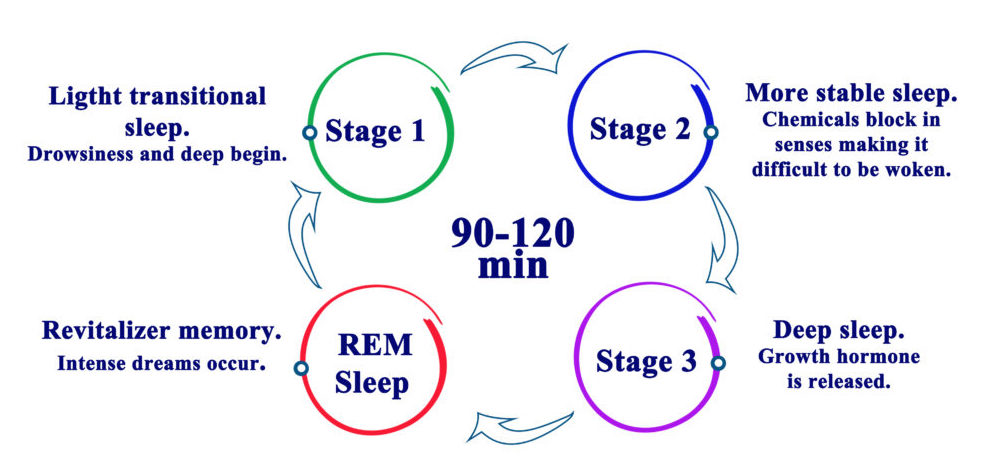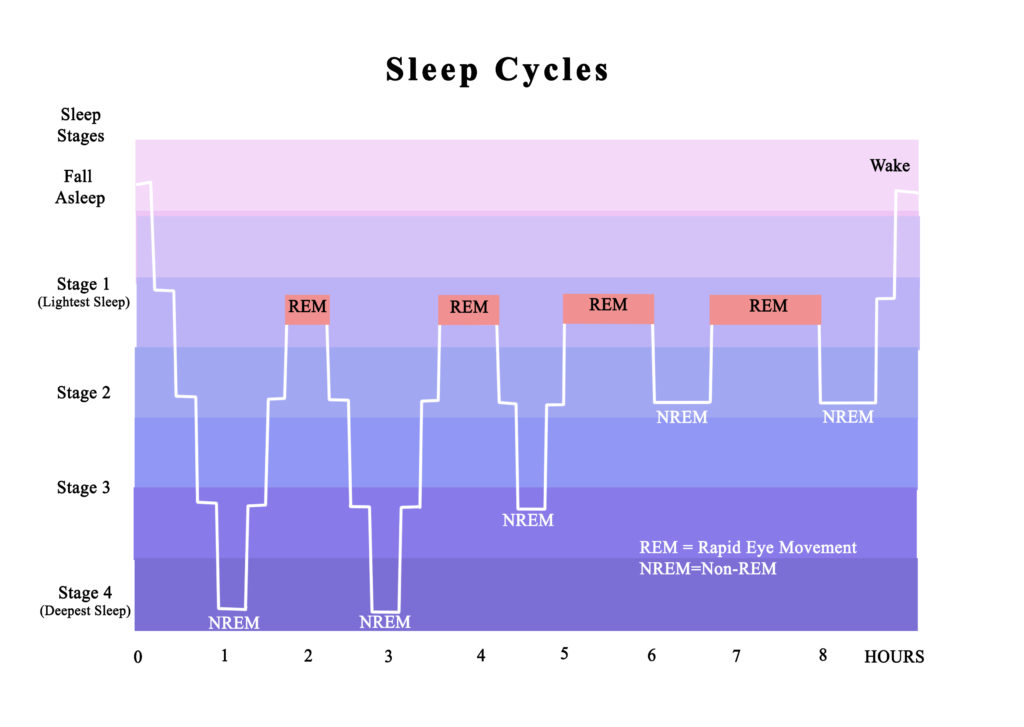Understanding the Human Sleep Cycle
Do you know that moment when you are tired and sleepy, but as soon as you go to bed, your body is like “just kidding!”? You are not the only victim; hat happens to many people. You pretty much spend all day just looking forward to going back to sleep only for that disappointment to kill the sleep vibe. That is just a piece of the many sleep disorders that exist: insomnia, sleep deprivation, sleep apnea, and snoring are common. In this article we will cover the sleep cycle. Understanding the human sleep cycle can help you to identify and address sleep-related disorders.
The Difference Between Sleep Cycles and Sleep Stages
A normal night sleep consists of sleep cycles and sleep stages. In each sleep cycle, there are usually four to five stages of sleep, and each of these stages serves a different purpose. The first four stages consist of non-rapid eye movement (NREM) sleep, and the fifth stage is when rapid eye movement (REM) sleep occurs.
Just like any other cycle, sleep cycle flows from stage one all through to REM and then begin again. The average time for each cycle is 95 to 110 minutes, each stage taking an average of 5 to 20 minutes. The first cycles have short REM sleeps and long deep sleep, but this alternates as the night get deeper. Meaning, REM sleep lengthen and deep sleep shorten.

What Are the Different Sleep Stages?
Here is a breakdown of each sleep stage and their individual purpose:
Stage 1 (Light sleep): Also known as the transitional phase. In this stage your eyes are closed in a light sleep, but you can easily wake up. Here the eye movement is slow, and muscle activity is also low and people slowly become unconscious. Many people experience falling muscle sensations that wake them up. This “sleep starts” are caused by motor areas of the brain being stimulated spontaneously. They are well known as hypnic myoclonia or myoclonic jerks.
Those who pray and meditate before sleeping are often quoted saying they “drift off” at this stage. At this phase some people also experience hypnagogic hallucinations, dream-like sensations. They may hear a doorbell or a phone ringing. This stage averagely lasts for 7 minutes. There is no problem with slightly more or slightly less. After phase one ends you slide into stage two.
Stage 2 (Unconscious sleep): People spend almost half of their sleep time in this stage. Here the heart rates gradually slow down and the body temperature decreases. Eye movement stops and the brain occasionally produces rapid brain waves. These waves are called sleep spindles. Stage 2 is highly characterized by an alternate between muscle relaxation and muscle tone.
Stage 3 (Deep sleep): It is a transition stage from light sleep to deep sleep. Slow brain waves known as delta waves are intermixed with faster waves. This is the first stage of deep sleep and is often hard to wake up from. Stage 3 usually lasts for about 25 minutes. Behaviors known as parasomnias, bed-wetting, sleepwalking, talking during sleep are experienced in this stage. This has been explained by some medics as an effect of the transition from non-REM sleep and REM sleep.
Stage 4 (Deeper sleep): This is the second stage of deep sleep also referred to as Delta sleep. The brain produces exclusively delta waves. Blood pressure drops and breathing becomes deeper and rhythmic. In this stage the body becomes completely refreshed. Hormones are also produced to stimulate growth and control appetite. Appetite control hormones help control hunger the following day. If this stage is short, sleep will not be satisfying. This stage lasts for about 30-35 minutes. Parasomnias may also occur in this stage.
Have you ever tried waking someone up and they can’t comprehend things, speaking nearly in tongues and are disoriented? It’s because they were in this stage of sleep. One is deepest asleep in this stage.
When Are We Dreaming?
In stage 5, also known as REM sleep (Rapid Eye Movement): Unlike other phases, this stage of sleep is characterized by the brain loaded with activity. The brain functions like it would in the waking stage although the eyes remain closed but move from side to side (therefore the name). The movement can be related to brain activity or an intense dream.
A fascinating fact is that voluntary muscle movements are paralyzed in this stage. That’s right. This is an exceptional design to help you protect yourselves from the dreams. Ever felt like running from your dream? Spoiler alert, you can’t, your legs are deprived off that privilege. A normal human being can dream 3 to 6 times in a single night. Recent research has shown that all people dream, whether you remember your dream or not. Men may develop erections in this stage. Adults spend around 20% of sleep time in this stage while as children spend about 50%.
People begin waking up in this stage and breathing becomes slower and irregular; the heart rate, blood pressure, and temperature begin to rise. This is to prepare the body for the activities of the day.
How Do We Experience the Different Sleep Stages?
It has been believed for some time that a person experiences the sleep stages in a continuous linear fashion. Recent studies have differed with that saying that one normally proceeds from stage 1 to 4 in order and most people go back to phase 2 and 3 before going to the REM phase. On average a night will repeat the sleep cycle 4-5 times.
Despite there being a sleep cycle, as we have seen, you may be repeatedly interrupted and you can’t follow the cycle as we have discussed. This situation is called a sleep disorder. Sleep disorders are in their numbers, insomnia, snoring, sleep Apnea and Circadian Rhythm Disorders just to mention a few. If you are experiencing a broken or an incomplete sleep cycle, then it may be a result from one of the many sleep disorders.
In conclusion, understanding the sleep cycle is essential to an individual so he/she can reap the maximum benefit of sleep. I hope this article is of benefit to you and it will help you create awareness of the stages of sleep. Help a person help another person and let us spread the word on the sleep cycle. Remember knowledge is of no value unless you put it into practice.
